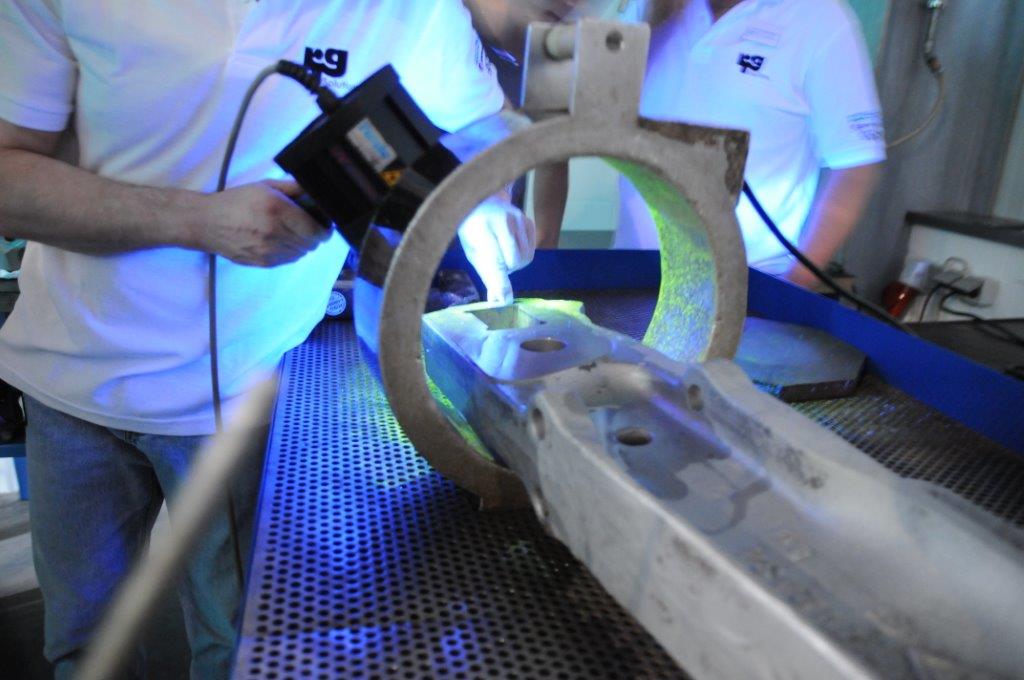Recognize risks before they arise!
Reliability and precision are two important features of tests and their results. For this, you need a well-trained and certified team of material testing personnel on the one hand, and on the other hand, the appropriate technical and spatial conditions. These requirements are met at nsp Prüf- und Servicedienste.
As a member of the DGZfP (German Society for Non-destructive Testing) and as your reliable testing and service partner, we will naturally comply with the respective standards and regulations as well as the safety-at-work regulations. We achieve utterly reliable and repeatable results with our modern test equipment.
Visual tests and surface crack tests
For the testing orders of our customers, we have three separate test cabins of approx. 21 m² each at our disposal in which we conduct the visual tests and surface crack tests. Depending on the test procedure and required general conditions, the test cabins can be illuminated or darkened for the inspections according to the standard.

For the magnetic particle testings (fluorescent and black/white), we use equipment that allows us to test according to both DIN EN ISO and ASTM standards. The components are magnetized by means of a magnet coil (parts up to a diameter of approx. 300 mm), hand-held yoke or high-current generator. The latter also allows us to demagnetize the tested parts.
Test objects of non-ferromagnetic material are examined for possible flaws by means of a dye penetration test.
Besides the calibrated standard measuring tools and gauges for the visual test of components, we have a video endoscope to inspect hoses, pipelines and other inaccessible test objects up to a depth/length of 9 m and to visually document the inspection.
Ultrasonic testing of inner material structures and wall thickness measurement
Another part of our range of services is the testing of inner structures of components and materials by means of ultrasonic waves (pulse-echo technique) to detect inside defects. For this purpose, we have digital testing devices with A-mode and suited for DGS evaluation which we can adapt to the test conditions by means of several angle probes and straight beam probes.
For measuring the wall thickness, we also have digital testing devices with A-mode to determine the thickness of walls and other coatings.
Pressure test
Pressure and leakage tests are conducted in two separate pressure chambers (12.0 x 3.8 m and 9.5 x 1.9 m) which are operated from the outside. These chambers are specially reinforced to protect our employees from hazards arising from test objects. Due to the installation of unbreakable special glass, we can observe the components during the test from the outside and check for damages or leakages.
Pressure tests can be conducted on a stationary compression testing machine in Vechta (documented for pressures of up to 2500 bar) and on a mobile test stand (documented for pressures of up to 1600 bar) on-site.
Each test is documented in a computer-based diagram and included in a test report.
Test laboratory
The establishment of our testing laboratory in Vechta in 2007 allowed us to expand our service to include the testing of chemical and physical material properties. We are testing materials for their different characteristic values. In addition to the offered analytical methods we also produce material samples and micrographs.
Spectrum analysis
Using optical emission spectroscopy (spectrum analysis), we examine the chemical composition of materials in reference to the Key of Steel (German: Stahlschlüssel). Each test is documented in a computer-based diagram and included in a test report.
The spectrum analysis is also carried out on-site.
Hardness test
In addition to a stationary low-load hardness tester in the range of HV 0.1 to HV 2.0, we can provide a mobile digital universal hardness tester as well as a device for Shore A hardness testing.
Load testing/ tensile tests
To test the tensile strength of components, we have a hydraulic test bench (tensile force of up to 5 t). This allows us to apply a load to designated areas of the test objects or even exert tensile forces until breaking occurs. This process can be documented in a computer-based diagram.
Calibration
As part of the periodic maintenance and testing, as well as to ensure the reliability of displayed results, we are offering the calibration of manometers and pressure generators (up to 1600 bar). The calibrations can be completely documented in computer-based diagrams and performed on-site due to our mobile testing devices.


